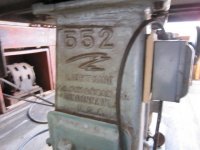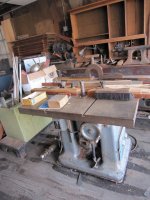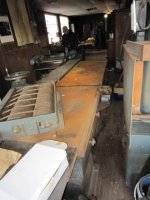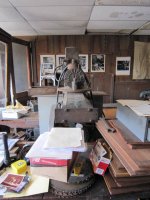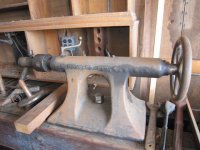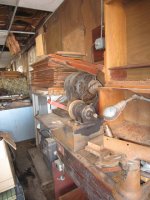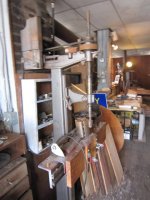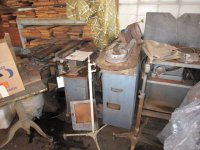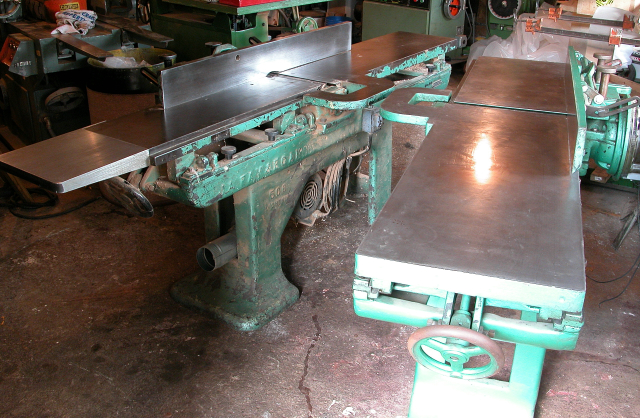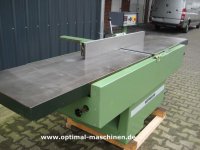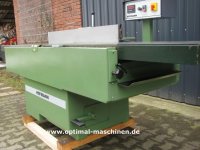duckfarmer27
Stainless
- Joined
- Nov 4, 2005
- Location
- Upstate NY
I put up a post of a jointer I got this past weekend. It came out of a cabinet shop in the Pittsburgh, PA area. Owner worked up until a couple of years ago, second generation owner. He is now in a nursing home and the tools are being sold. I took some pictures and have some descriptions. However, I am going to apologize up front for not doing a complete inspection. It was going to be a 6+ hour return trip for us, and as we were second in line we did not get loaded and tied down until early afternoon. So I rushed some pictures.
First item is an Oliver jointer - a big one, with a power feeder. I did not measure, believe it to be 20". I had to squeeze in to read the shop number - I could clearly read 1_777 - but I don't know if there is a faint numver between the 1 and the 7s. It is typical Oliver double pedestal.
There is a Fay and Egan 552 'Lightning' shaper and what looks like a fair amount of tooling, think I saw a spare spindle.
The old lathe is just marked as an Egan - it has an 8' wooden bed with what appears to be angle iron ways. Lots of lathe tools.
Other machines in pictures are a Multiplex 60 radial arm saw, what I think is a mortiser (no name I could find) that was converted to do doweling it seems. Also some sanders, small table saws, etc. I did screw up by not taking a picture of the drill press. Not a camel back, what I would call a column drill (?) with some of a down feed mechanism. It had a build tag from Hartford, CT but I can't remember the maker.
I have no relationship with the owner, nor the lady who is selling the items for him. I offered to help her out by letting people on this board know as to date she has only been trying Craigs List and wants to get the stuff moving. She was great to deal with, and if you have questions she and her husband try to get an answer. Figured this part of PM was best to post as it is all wood working machinery. The owner did some fantastic inlay work, and built beautiful furniture - pictures I saw made me wish I could have known him as I would have learned something.
I will put pictures in the next couple of posts.
If you have interest PM me or post - I will give the lady's email.
Thanks.
Dale
First item is an Oliver jointer - a big one, with a power feeder. I did not measure, believe it to be 20". I had to squeeze in to read the shop number - I could clearly read 1_777 - but I don't know if there is a faint numver between the 1 and the 7s. It is typical Oliver double pedestal.
There is a Fay and Egan 552 'Lightning' shaper and what looks like a fair amount of tooling, think I saw a spare spindle.
The old lathe is just marked as an Egan - it has an 8' wooden bed with what appears to be angle iron ways. Lots of lathe tools.
Other machines in pictures are a Multiplex 60 radial arm saw, what I think is a mortiser (no name I could find) that was converted to do doweling it seems. Also some sanders, small table saws, etc. I did screw up by not taking a picture of the drill press. Not a camel back, what I would call a column drill (?) with some of a down feed mechanism. It had a build tag from Hartford, CT but I can't remember the maker.
I have no relationship with the owner, nor the lady who is selling the items for him. I offered to help her out by letting people on this board know as to date she has only been trying Craigs List and wants to get the stuff moving. She was great to deal with, and if you have questions she and her husband try to get an answer. Figured this part of PM was best to post as it is all wood working machinery. The owner did some fantastic inlay work, and built beautiful furniture - pictures I saw made me wish I could have known him as I would have learned something.
I will put pictures in the next couple of posts.
If you have interest PM me or post - I will give the lady's email.
Thanks.
Dale


